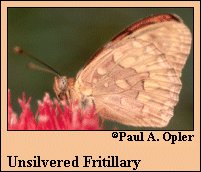 |
 

 |



Unsilvered Fritillary (Speyeria adiaste [W. H. Edwards])
Wing span: 2 - 2 3/8 inches (5 - 6.1 cm).
Identification: Upperside of male pale reddish-tan to bright brick red; female larger and paler than male. Dark markings scattered and small except for bold postmedian line. Underside pale yellow to gray. Hindwing spots unsilvered and barely contrasting with background color.
Life history: Eggs are laid singly on fallen leaves and twigs near violets. First-stage caterpillars hibernate unfed, feeding on violet leaves in the spring.
Flight: One flight from June-July.
Caterpillar hosts: Violets including Viola quercetorum.
Adult food: Flower nectar.
Habitat: Openings in redwood and coniferous forests, oak woodlands, chaparral.
Range: Very local, restricted range in California: San Luis Obispo County north to San Mateo County; east to north Los Angeles County and Kern County.
Conservation: Subspecies atossa is extinct; subspecies adiaste has a limited range and may be in jeopardy; while subspecies clemencei has the most extensive range.
The Nature Conservancy Global Rank: G3 - Very rare or local throughout its range or found locally in a restricted range (21 to 100 occurrences). (Threatened throughout its range).
Management needs: Inventory and monitor subspecies adiaste populations and make conservation assessment.
References:
Scott, J. A. 1986. The butterflies of North America. Stanford University Press,
Stanford, Calif. 583 pages, 64 color plates.
Tilden, J. W. 1986. A field guide to western butterflies. Houghton-Mifflin Co.,
Boston, Mass. 370 pages, 23 color plates.
Author: Jane M. Struttmann

